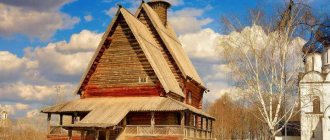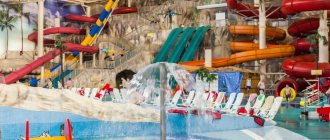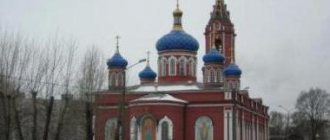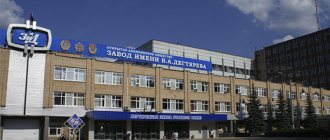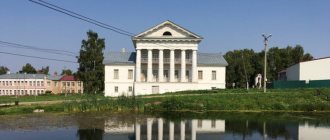general information
Previously, it was believed that Dubna was a young populated center. However, materials have been found that prove its age at 800 years. The first settlement on the territory was founded by Yuri Dolgoruky in 1134. Since then, the village was burned, destroyed by the Mongol-Tatars and rebuilt later.
There are many attractions in Dubna - both related to physics, history, and nature. Here you can see museums, monuments, the embankment and other interesting places.
The city is constantly undergoing restoration of ancient objects, so it is better to pre-register for excursions. The guide will not only be able to conduct a tour, but also tell historical facts about Dubna.
DUBNA
DUBNA, a city in Russia, in the northern part of the Moscow region, the center of the urban district of the same name. Population 75.0 thousand people. (2019). Located on the river. Volga, near the confluence of the river. Dubna. The Moscow Canal begins near Dubna (Bolshaya Volga pier). 2 railway stations (Dubna, Bolshaya Volga).
Story
Photo by E. M. Podolskaya Dubna. View of the city from the Volga.
In the 1930s near modern Dubna, construction of a canal began (including the Volzhsky hydroelectric complex, the dam of the Ivankovskaya hydroelectric station, etc.), and the workers' settlements of Bolshaya Volga (on the right bank of the Volga) and Ivankovo (on the left bank; since 1958 a city) arose. In 1937–39 in the village. A plant for the production of seaplanes was built in Ivankovo (now the Dubninsky Machine-Building Plant, one of the city-forming enterprises of Dubna). Since the late 1940s. is developing as a center for fundamental research in the field of elementary particle physics and nuclear physics (the Institute of Nuclear Problems and the Electrophysical Laboratory of the USSR Academy of Sciences were established near the village of Bolshaya Volga). A residential village was built in 1954–56. Dubno, Kalinin region (now Tver region), in 1956, in connection with the creation of the Joint Institute for Nuclear Research, the village was transformed into a city (it included the village of Bolshaya Volga, the villages of Aleksandrovka, Novoivankovo, Ratmino, Kozlaki, Yurkino) and transferred to the Moscow region , since 1958 the modern name. Since 1956 it has been a city of regional subordination of the Moscow region. In 1960, the city of Ivankovo was included within the boundaries of Dubna. In 2001, the city was awarded the status of “Science City of the Russian Federation”. Since 2005, the center of the city district of the same name. In 2005, a Special Economic Zone was created in Dubna by decree of the Government of the Russian Federation.
Architecture. Culture Center
Dubna is characterized by urban areas with remnants of forest areas. In the eastern part of the city (the former village of Ratmino), a church in honor of the icon “Praise of the Blessed Virgin Mary” (1827, 2nd half of the 19th century, 1907–14) has been preserved. The statue of V. I. Lenin (1937, sculptor S. D. Merkurov) formed a monumental composition on the banks of the outpost of the Volga hydroelectric complex with the statue of I. V. Stalin (dismantled in 1961). Many buildings are in the style of Soviet neoclassicism (including the complex of buildings of the Joint Institute for Nuclear Research, the House of Scientists and the House of Culture "Mir"). In the 1990–2000s. erected: the building of the state boys' choir school "Dubna", a temple in the name of All Saints who shone in the Russian land, etc. Museum of Archeology and Local History. City Symphony Orchestra (1990). International class water stadium. Dubna is the site of major international chess tournaments (1971, 1973, 1976 and 1979).
Scientific centers
In Dubna there are also: Institute of Physical and Technical Problems (development and production of analytical instruments based on PP detectors, radioisotope devices for technological control and automation of technological processes for the nuclear industry, etc.), Research Institute of Applied Acoustics, a branch of the Research Institute of Nuclear Physics of Moscow State University, Research Institute " Atoll" (development and production of hydroacoustic communication and navigation systems for shipbuilding). "State Machine-Building Design Bureau "Raduga" named after A. Ya. Bereznyak" (development of missile weapons for the Air Force and Navy, wind power plants, manned light aircraft, etc.), OKB "Typhoon" (design of small and ultra-small aircraft). Space Communications Center "Dubna" (one of the divisions of the state enterprise "Space Communications").
Educational centers
Among the universities are the International University of Nature, Society and Man "Dubna" (1994), a branch of the Moscow Institute of Radio Engineering, Electronics and Automation, a representative office of the International Academy of Marketing and Management (MAMARMEN), the Regional Center of the International Institute of Management LINK, the Educational and Consulting Center of Moscow State University service; branch of the Moscow Regional Polytechnic College, educational. Near Dubna is the Barki airfield (training base of the Russian National Aero Club).
Farm
Among the industrial enterprises of the city: “Dubna Machine-Building Plant named after N.P. Fedorov” (manufacture and repair of aircraft guided weapons, means of their ground support, production of parts, components and assemblies for aviation equipment), “Tensor Instrument Plant” (1968; production of automated monitoring and control systems for technological processes, security alarm systems, fire protection, etc.), “Research and Production Complex “Dedalus”” (within the structure of Rosatom State Corporation; development and production of devices and systems for the protection of military and civilian facilities), "Research and Production named after. Yu. K. Nedachina" (spectrometric, radiometric and dosimetric equipment), "Microtechnology" (integrated electronic circuits and micromodules). Ivankovskaya hydroelectric power station operates (1937–38; capacity 28.8 MW).
Top 10 attractions of Dubna
When visiting Dubna, you won’t be able to see the sights in one day. Therefore, I recommend staying in the city for at least a weekend. In addition, you can take a walk around the surrounding area, enjoy the beauty of nature and have a good rest.
Ivankovskaya HPP
The hydroelectric power station was built in the 1930s. Next to it, the village of Bolshaya Volga arose, where the builders lived. The water power plant is part of the canal named after. Moscow.
The local reservoir supplies the capital and neighboring cities with water. It also has another name - the Moscow Sea. Local residents and tourists love to relax on the bright, mesmerizing shores.
The hydroelectric power station connects the two halves of Dubna by road, i.e. serves as a bridge. From the shore there are views of the outport, the monument to Lenin and the platform on which the statue of Stalin previously stood. The hydroelectric power station is considered a monument to Soviet times.
Ivankovskaya hydroelectric power station was built in 1930.
Mendeleev Embankment
Clean air and the location of the embankment next to the river help to escape from the bustle of the city. Aesthetic alleys and white gazebos with benches will appeal to everyone.
You will also like: Kolomna: the main attractions of the city
While walking, you can get to the bust of D.I. Mendeleev. The 105th element, named after the city, was obtained here in the laboratory headed by nuclear physicist G.N. Flerov. There are other busts of famous people on the embankment. The area is constantly being reconstructed and landscaped.
Mendeleev Embankment is good for walking.
Museum of Archeology and Local History
I recommend going to the museum. The exhibits on display are findings from the territory of old Dubna, its original settlement. The city's heritage dates back to the 12th-13th centuries.
Among the collections you can see various women's jewelry, weapons, and dishes. Also on display are clothing, Orthodox items, skeletons and animal fossils.
The Museum of Archeology and Local History has many different exhibitions.
Moscow Canal
In the past, the city authorities realized that residents would not have enough drinking water for long. The Moscow River was drying up and could be forded. Water shortages were observed in Soviet times, but began during the reign of Peter I and Catherine II.
Several projects were considered in Stalin's office, but the most suitable one was chosen, which connected the Moscow River with the Volga. Workers had to dig a 128-meter canal and build a lock system.
The work was hard, the very first reservoir was Ivankovskoye. Walking along the canal, you can admire the buildings located along it.
128 meter Moscow Canal.
Lenin monument
In 1937, sculptor S.D. Merkulov erected a granite monument to Lenin, 37 m high and weighing 540 tons. On the contrary, on the other side of the canal named after. Moscow, there was a sculpture of Stalin, but it was blown up (the steps and pedestal remained).
Previously, the area was beautified, paths were made from broken bricks, and rays of light from spotlights were directed at Lenin. Now the thuja grove behind the statue has grown, the lanterns are broken, and the paths are overgrown with grass.
The Lenin monument is 37 meters high.
Temple of the Smolensk Icon of the Mother of God
The temple is made of wood according to all the parameters of Russian architecture and construction of those times. The idea of building a church appeared in 1994.
Centuries-old trees grow around the building. There is a wooden cross on the territory of the temple; a path leads to it from the entrance gate. This is the main composition, which gives information about the date of foundation of the cathedral.
The Church of the Smolensk Icon of the Mother of God is built entirely of wood.
Mosaics by Nadia Leger
Nadya Leger is a Russian artist who was married to a Frenchman. After the death of her husband, she continued his work. She was interested in mosaics, and the girl made a number of portraits of people of the 19th-20th centuries.
You'll also like: Where to go on New Year's holidays with children
In 1972, an exhibition of paintings was held in France, where there were 65 Léger exhibits. Now these mosaics decorate the alley next to the Mir cultural center.
Mosaics by Nadia Leger are located along the alley.
Monument to Vysotsky
The singer’s sculpture was placed in 2008 next to the Mir cultural center. He performed in this building more than once. The alley where Vysotsky stands is also named after the singer. Here you can not only stroll along the paths, but also take beautiful photos.
Monument to Vysotsky in the park near the cultural center.
Monument to Pontecorvo and Dzhelepov
On one of the alleys of the science city, not far from the monument to Vysotsky, there is an interesting sculpture of physicists:
- V.P. Dzhelepova;
- B.R. Pontecorvo.
It reflects the erudition and everyday communication of people of science. The authors of the monument are D. Yarmin and V. Sergeev.
Pontecorvo became famous for his knowledge of searching for oil fields, and Dzhelepov developed the treatment of tumors using proton beams. The scientists had a good sense of humor and a love of sports.
Monument to physicists Pontecorvo and Dzhelepov.
All Saints Church
Construction of the building began in 1993 on the site of the cemetery. The church was erected quickly, and later they began to build a chapel next to it in honor of Daniil of Pereyaslavl. Workers have completed construction of the main building, but even now the interior decoration is underway. Funerals and services are held in the church named after. Panteleimon.
The Church of All Saints is currently active.
What to see in non-tourist Dubna
In our country there are a huge number of cities popular with tourists, rich in attractions, about each of which you can find a lot of information and colorful reviews. But there are settlements in which some of us live or come to visit or on business, and often do not even notice the uniqueness of this or that place. Meanwhile, in every village or city there are curious objects, natural or man-made, that are worth paying attention to, if only to broaden your horizons. Today I want to talk about the fairly young city of Dubna, which is primarily known for its nuclear research center. In addition, it is the only city in the Moscow region that is located on the banks of the Volga. What should a tourist who finds himself in Dubna see?
1. First of all, a huge monument to V.I. Lenin is thirty-seven meters high. This is the second largest monument to a leader in the world. It was made by the sculptor S. Merkurov, it was he who removed the death mask from Vladimir Ilyich and made quite a few monuments to Soviet political figures. This monument was erected on the bank of the Moscow Canal in 1937. Opposite was the same gigantic figure of I.V. Stalin, but it was blown up in the sixties after the cult of personality was exposed. Now only a pedestal remains in its place.
Dubna
We started our walk precisely from this place and first looked at Lenin from afar, and then drove closer.
Dubna
Near the parking lot we see a monument to the builders of the Moscow Canal.
Dubna
More than 22,000 prisoners died at this grandiose construction site in the thirties. A small evergreen alley leads to Lenin, while he stands with his back to us.
Dubna
We go ashore. Even in winter it’s very beautiful here, and in summer it’s probably absolutely stunning.
Dubna
But we are interested in the monument to the leader. It really is just huge.
Dubna
And although I am against such monuments standing in city squares, here it is perhaps worth leaving for history.
2. Next to the Lenin monument is the Big Volga Lighthouse, which stands on the spot where the Moscow Canal flows into the Ivankovskoye Reservoir.
Dubna
3. At the entrance to Dubna on Priborostroiteley Street you can see a giant chair. This is the second huge building in Dubna: first Lenin, then a chair, maybe something else will appear soon. This chair, nine and a half meters high, appeared in Dubna in 2004 on the initiative of the director of the local enterprise Ecofurniture and is considered the tallest wooden chair in the world.
Dubna
4. The director of the furniture factory did not stop at the giant chair. He carefully studied the map and found out that Dubna, it turns out, is located in the center of the European part of Russia. To mark this, a memorial sign was installed next to the huge chair, on which you can see the distance in kilometers from Dubna to the most extreme points of Russian Europe.
Dubna
5. Next to the chair on Instrument Makers Street there is a young, but very beautiful snow-white Church of All Saints, who shone in the Russian land.
Dubna
6. In Tserkovny Proezd you can see another new, but rather monumental Church of John the Baptist.
Dubna
Then we go to the institute part of the city, which was formed around the nuclear research center. Comfortable cottages were built for scientists, in which scientists or their descendants still live.
Dubna
7. House of Culture “Mir”, built in the 50s. 20th century in the Stalinist Empire style.
Dubna
V. Vysotsky gave concerts here several times.
Dubna
A memorial plaque and a monument to the poet tell us about this.
Dubna
8. Near the Mir cultural center you can admire a number of works by artist Nadya Leger. There are several mosaic portraits of famous figures here, such as ballerina Maya Plisetskaya, composer Dmitry Shostakovich, poet Vladimir Mayakovsky and others.
Dubna
I really liked the images of Maxim Gorky and Zoya Kosmodemyanskaya.
Dubna
9. There are several monuments to physicists in the park. The first, to one of the founding fathers of the nuclear research center M.G. Meshcheryakov, associate I.V. Kurchatova.
Dubna
10. Second, to two nuclear physicists Bruno Pontecorvo and V.P. Dzhelepov.
Dubna
11. A very cozy and pleasant place for walking in any weather in Dubna is the Mendeleev embankment.
Dubna
But it is especially beautiful in May, when the apple trees bloom here. The real decoration of the embankment are the rotundas built in the 50s. XX century.
Dubna
From them you can go down to the Volga, even in winter this river has some kind of attractive force.
Dubna
Dubna
12. We also managed to visit the Dubna Museum of Archeology and Local History, located on 11 Mokhovaya Street. Unfortunately, we arrived at the museum quite late, and there was no one to give us a tour. However, a huge advantage of the museum is the presence of a video tour that spontaneous tourists like us can listen to. It tells in some detail about all the exhibits. The Dubna Museum of Archeology and Local History has an interesting collection of archaeological finds.
Dubna
Fossilized mollusks and shells tell of the period when the local area was the bottom of the world's oceans, then we see objects from the Stone and Iron Ages. Despite the fact that Dubna is a fairly young city, its history goes far back. In the XII-XIII centuries. on the site of the Ratmino district on the banks of the Volga there existed the Russian city of Dubna; in the museum you can see household items found during excavations at the site of the ancient city. Separately presented are items of furniture and everyday life of village residents who were located on the territory of Dubna in the 19th and early 20th centuries.
Dubna
Important stages in the life of the city were the construction of a hydroelectric power station and a canal named after Moscow, the Great Patriotic War and the formation of a science town and a nuclear research center.
Dubna
Of course, these are not all the interesting places in Dubna, but only those that we managed to explore in one fairly short daylight hours. In Dubna there is also a castle museum, a museum of the history of science and technology, a sports museum and a natural history museum.
You can get to Dubna by train from Savelovsky station. The express train takes about two hours one way, the regular train takes two hours and forty minutes. There are also buses to Dubna from the Savelovskaya and Timiryazevskaya metro stations. A visit to Dubna can be supplemented with a road trip to Kimry and Taldom.
